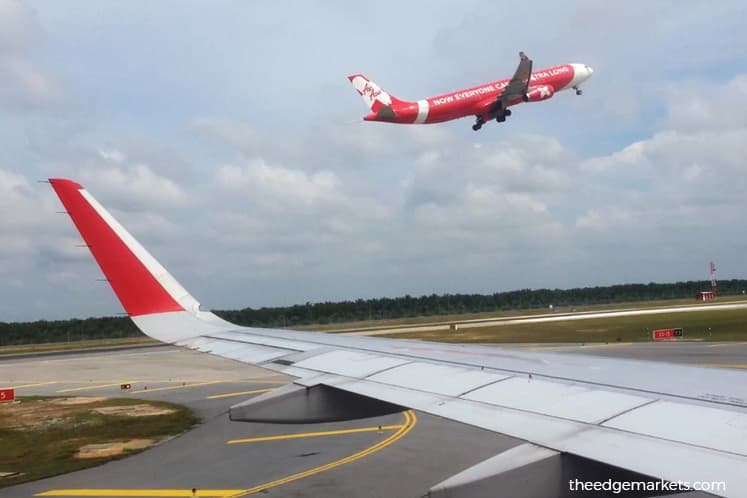
KUALA LUMPUR (Sept 25): Low-cost carrier AirAsia Bhd shares rose 2.93% at mid-morning trade today after CIMB Research said the airline had gained domestic market share quickly at the expense of its competitors, which will lead to strong yields and load factors for its second half financial year ending Dec 31, 2017 (2HFY17).
At 11.20am, AirAsia rose 10 sen to RM3.51 with 3.54 million shares traded, for a market capitalisation of RM11.7 billion. Year to date, the counter has risen about 53%.
CIMB Research is maintaining its “add” rating on AirAsia, with unchanged target price of RM3.51.
In a note today, its analyst Raymond Yap said AirAsia started this year with 102,000 domestic weekly seats, but is expected to end 2017 forecast with around 114,000 seats per week from Kuala Lumpur International Airport (KLIA), an increase of 12,000 seats per week.
“As a result, AirAsia’s market share of domestic seats from KLIA may rise from 51% to 60% by end-2017 forecast,” he said.
The research house said, Malaysia Airport Holdings Bhd (MAHB) traffic data clearly showed passenger traffic numbers have resumed growth since mid-2016, after two consecutive years of low single-digit growth, driven by international passenger traffic growth (+14.5% y-o-y) against slower growth for domestic passengers (+6% y-o-y).
“This is explained by the weak ringgit encouraging inbound tourists into Malaysia, as well the mature state of the domestic travel market,” CIMB Research said.
Additionally, passenger traffic at KLIA’s Main Terminal Building (MTB), where full-service carriers like Malaysia Airlines (MAS) and Malindo Airways Sdn Bhd (Malindo Air) are based, have seen a dramatic decline in passenger traffic growth from May 2017 onwards, slowing down to 12% to 13% y-o-y, from more than 20% y-o-y growth in the preceding months.
Meanwhile, in July and August this year, MTB passenger traffic growth slowed down to the low single-digits.
Yap noted MAS and Malindo have both cut domestic capacity from KLIA, in which Malindo deployed around 25,000 one-way domestic seats per week from KLIA at the start of 2017, but this declined to about 15,000 seats in early-April and is expected to remain at this level for the rest of the year.
Meanwhile, MAS started the year with about 75,000 domestic seats per week from KLIA, but with its capacity cuts in July to September, and the airline is expected to end the year with 62,000 seats.
“Altogether, MAS and Malindo are expected to reduce their domestic capacities from KLIA by 23,000 seats per week by end-2017 forecast, or a substantial drop of 23% measured from the start of the year,” he said.
With an absolute decline in total domestic capacity from KLIA but no sign of a decline in domestic passenger numbers, AirAsia is taking advantage of its competitors’ pullback by expanding its fleet by 10 planes in Malaysia in 2HFY17 forecast, after adding none in the first six months.
“We think AirAsia’s strategy to entrench itself strongly in Malaysia is a brilliant move to edge out its rivals,” Yap said.